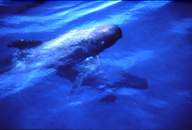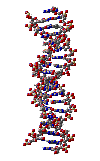|
What do a shark fin and a human leg have in common? (07/2006)
One of the most important milestones in the evolution of life occurred when paired fins (and later limbs) appeared, leading to new types of locomotion. Now, in the advanced online issue of Nature1, scientists show that, although originating from different cell types, human limbs and median fins share a common developmental mechanism. These results support the idea that it was from median fins that all fins and limbs evolved, a hypothesis that has been around since the 19 century, but, until now, has never been proved.
The earliest vertebrate fossils show only well-developed dorsal and ventral (median) fins what has led researchers to suspect that these were the basis for which all paired fins and limbs evolved. However, their different location (median versus side of the body) seemed to indicate that they appeared from different cells in the embryo, which challenged the common-origin idea.
In order to investigate the issue, Renata Freitas, a Portuguese scientist, together with Guang Jun Zhang and Martin J. Cohn, all working at the department of Zoology, University of Florida, studied the embryonic development of Catshark’s fins. Catsharks are sharks found in the Atlantic and owe their name to their flat heads and long, catlike eyes.
The researchers started by marking the different cells from the embryo and following their development, in order to understand which cells originated the different parts of the shark’s body. Next, they investigated the activity of different genes during fin development. From these two experiments, Freitas and colleagues discovered that the median fin of Catsharks, although originating from different embryonic cells, uses the same genes (Hox and Tbx18) during development as limbs and paired fins.
“Given that paired fins made their evolutionary debut at a particular location on the sides of the body, intuitively one would think the genetic tools for fin development would be brought together in that place,” said developmental biologist Martin Cohn, an associate professor with the University of Florida (UF) departments of zoology and anatomy and cell biology and a member of the UF Genetics Institute. “We’ve discovered that the genetic circuitry for building limbs first appeared in an entirely different place — the midline of the animal.”
To further confirm this hypothesis, Freitas, G Zhang and Cohn decided to study lampreys, which developed into an independent lineage before the appearance of the first modern fish (and so before the appearance of paired fins). Again, they found that lamprey’s median fin used the same developmental program as catshark’s median fins or human limbs.
“That we see these same mechanisms operating in lamprey fins tells us they must have been assembled in the median fins first, and later in evolution this entire genetic program was simply reutilized in a new position to build the first paired fins,” Cohn said. “It tells us our own arms and legs have their evolutionary roots in the dorsal, caudal and anal fins of our fishy ancestors.”
Furthermore, the fact that lampreys – one of the most primitive of living vertebrates- already use this fin’s developmental mechanism raises the possibility that this genetic program might have developed even before vertebrates. To investigate that, the researchers now plan to see if cephalocordates, which have appeared before the vertebrates, share a similar genetic mechanism behind the development of their fins.

1 Nature - advance online issue “Evidence that mechanisms of fin development evolved in the midline of early vertebrates” Renata Freitas, GuangJun Zhang and Martin J. Cohn
Authors of the original paper
|
In collaboration with the Observatório da Ciência e do Ensino Superior (OCES)
Financed by the Fundação para a Ciência e Tecnologia (FCT) |





